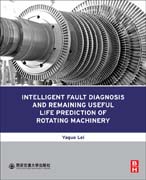
Intelligent Fault Diagnosis and Remaining Useful Life Prediction of Rotating Machinery
Lei, Yaguo
The prognostics and health management (PHM) of rotating machinery has attracted more and more attention recently due to its importance in enhancing the availability, the reliability and the security of rotating machinery. Intelligent Fault Diagnosis and Remaining Useful Life Prediction of Rotating Machinery provides a comprehensive introduction of intelligent fault diagnosis and RUL prediction based on the current achievements of the author's research group. The main contents include multi-domain signal processing and feature extraction, intelligent diagnosis models, clustering algorithms, hybrid intelligent diagnosis strategies, RUL prediction approaches, etc. This book presents fundamental theories and advanced methods of identifying the occurrence, locations and degrees of faults, and predicting the RUL of rotating machinery. Besides experimental demonstrations, many application cases are presented and illustrated to test the mentioned methods in the book. This valuable reference book provides an essential guide for the readers from machinery fault diagnosis to understand basic concepts and fundamental theories. Academic researchers with mechanical engineering or computer science background, and engineers or practitioners at companies take charge of machinery safe operation and maintenance will find this book is very useful. Provides detailed background and roadmaps of intelligent diagnosis and RUL prediction of rotating machinery, involving fault mechanisms, vibration characteristics, health indicators, diagnosis and prognosticsPresents basic theories, advanced methods, and latest contributions in the field of intelligent fault diagnosis and RUL prediction, like deep learning based intelligent fault diagnosis, adaptive clustering algorithms based fault identification, multidimensional hybrid intelligent diagnosis, and data-driven or model-based RUL prediction methodsGives lots of application cases. The methods, algorithms or models introduced in the book are demonstrated by some real applications and industrial experiences are summarized based on the cases. This arrangement would make the book both interesting and practical INDICE: 1. Introduction and background 1.1 Historical perspective 1.2 CBM/PHM 1.3 Intelligent fault diagnosis 1.4 RUL prediction 1.5 Conclusions References 2. Signal Processing and feature extraction 2.1 Introduction 2.2 Signal processing in the time domain 2.3 Signal processing in the frequency domain 2.4 Signal processing in the time-frequency domain 2.5 Conclusions References 3. Individual intelligent techniques based fault diagnosis 3.1 Introduction 3.2 Artificial neural networks 3.3 Statistical learning theory 3.4 Deep learning 3.5 Conclusions References 4. Clustering algorithms based fault diagnosis 4.1 Introduction 4.2 K nearest neighbor based fault diagnosis 4.3 Fuzzy c-means based fault diagnosis 4.4 Hybrid clustering algorithm based fault diagnosis 4.5 Conclusions References 5. Multidimensional hybrid intelligent diagnosis 5.1 Introduction 5.2 A multiple WKNN combination based fault diagnosis 5.3 Multiple ANFIS hybrid intelligent fault diagnosis 5.4 A multiple classifier hybrid intelligent method 5.5 Conclusions References 6. RUL prediction 6.1 Introduction 6.2 Indicator construction in RUL prediction 6.3 Data-driven prediction methods 6.4 Model-based prediction methods 6.5 Conclusions References
- ISBN: 978-0-12-811534-3
- Editorial: Butterworth-Heinemann
- Encuadernacion: Rústica
- Páginas: 400
- Fecha Publicación: 10/11/2016
- Nº Volúmenes: 1
- Idioma: Inglés
